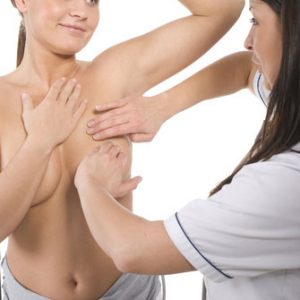This is a pretty unpleasant condition, as is manifested by itching, uncomfortable feelings, in this case the skin dries and peels off, creating, in addition to medical and aesthetic problems.
Nipple eczema is a skin inflammatory and allergic nature, which is manifested in the form of erythematous-vesicular (spotted-vesicular) rash around the nipples and alveoli.
Treatment of eczema of the nipple complex and multi-component.
Reasons
Most often, the nipple eczema appears as a post-traumatic complication of lactation (formation and release of breast milk) in women who are predisposed to allergic reactions and are observed at the allergist in occasion of a disease.
Due to direct contact with the external environment nipples are not sterile, microorganisms that reside on their surface, involved in the development of eczema of the nipple. Revealed that over 50% of women with a diagnosis of eczema of the nipples is a disease developed on the background of pathogens – the waste products of microorganisms and decay of dead microbial bodies create favorable conditions for the development of inflammatory and allergic reactions. Therefore, mammalogy, allergists and dermatologists regard the eczema of the nipples as a form of microbial eczema.

In the examination of patients with this diagnosis often revealed nonspecific microflora that can cause infectious pathology of the various organs and tissues. Often with eczema of the nipples are identified such agents as:
and some others.
Less frequently identified representatives of the specific microflora, provided that they previously “occupied” a woman’s body.
Most often it is:
- Mycobacterium tuberculosis (tubercle Bacillus);
- Treponema pallidum – the causative agent of syphilis;
- Candida – pathogenic fungi;
- actinomycetes – radiant fungi
and several others.
Highlighted a number of factors that are direct causes of eczema of the nipples are not but contribute to its development. This:
- stress – particularly associated with caring for a child in the first days and months of life.
- insufficient production of glucocorticoids – hormones of the adrenal cortex;
- feeding habits – namely diet;
- infectious disease – in this case the infectious focus may be anywhere in the body;
- close contact with harsh household chemicals;
- wearing synthetic and incorrectly matched in size lingerie.

In the initial period of lactation in the mammary glands still produced enough milk, the baby makes a significant effort to suck the colostrum. Because of his active sucking and nipple area of the alveoli can injure. Enough injuries in the form of microcracks, to the accession of the infectious agent developed eczema of the nipple. Zamachine that the risk of the described diseases due to trauma of the nipples increases during feeding of the child with a short frenulum of the tongue – he makes more efforts to capture the nipple and areola, compounding their trauma.
Revealed that patients who have previously been diagnosed with allergic diseases (even short-term allergic reactions), are more likely to develop eczema of the nipple. Even if these women had not previously complained of allergic symptoms during the examination, they found the increase in the number of one of the factions of immunoglobulin – IgE. At the same time revealed the genetic propensity to this type of allergic reaction.
Stressful situations play a role in the development of eczema of the nipple. During stress, enhanced sympathetic tone – element of the autonomic nervous system. This in turn provokes the release into the blood more servings of histamine – biological compounds, which enhances the allergic and inflammatory reactions (in this case, the area of the nipple, which, moreover, because breastfeeding is more sensitive than in unelection period). As child care (especially in the first days and weeks after his birth) may be accompanied by nervous tension until the development of stress, the described mechanism contributes to the development of eczema of the nipple.
For patients with a predisposition to allergic reactions is characteristic of insufficient secretion of glucocorticoids, one function of which is inhibition of the inflammatory process. Lack of glucocorticoids leads to a prolonged duration of eczema of the nipple.
Of dietary habits that may contribute to the development of the described diseases, it is important to use products such as:
- red vegetables and fruits – tomatoes, peppers, strawberries and others;
- citrus – most often it is the lemons;
- chocolate;
- smoked products – sausages, smoked sturgeon, smoked fish
and some others.
The risk of developing eczema of the nipples increases if the woman is ill of any infectious disease is the source of microorganisms “supplies” of pathogens that affect the nipple, already compromised allergic and inflammatory reactions. In addition, infectious agents weaken the immune system.
A factor that contributes to the development of eczema of the nipples is a close contact of a woman with aggressive household chemicals – in particular, the use of poor quality detergents for washing bras, Soaps, foams and gels. They irritate the tissue of the nipples and areolas, thereby contributing to the development of the described disease.
Similar is the principle exposure of the nipples and areola synthetic and tight underwear – it has irritating effect on tissues.
The development of the pathology
The basis for the development of eczema of the nipples are the following pathological processes:
- local inflammatory reaction;
- allergic reaction, often due to hereditary factor;
- the so-called neurohumoral changes – a violation of the nervous regulation of the tissue of the nipples and areolas and the regulation of active substances (hormones, neurotransmitters, and so on).

The most important link in the development of the pathological process is of the immune and inflammatory processes that are observed in the lesion. When the baby sucks mother’s breast, such a mechanical effect on the nipple and areola triggers the secretion of inflammatory mediators – chemicals that trigger the inflammatory process. This, in turn, causes sponges – swelling surface layer of cells that cover the nipple and areola.
With further progression of the described tissue reactions developing parakeets – keratinization of the cells. Because of this, on the nipple and areola occur characteristic rash. Tissue to swell and become tight – this process develops due to the fact that in the area of inflammation rush the lymphocytes (a type of immune system cells). Their large concentration leads to the development of acanthosis excessive pigmentation of the nipples.
It should be borne in mind that the described pathology likely to relapse. Even after, it seemed, a complete cure with the help of competent appointments manifestations of eczema of the nipples may occur again.
Symptoms of nipple eczema
The clinical course distinguish between three forms of nipple eczema:
- sharp;
- subacute;
- chronic.
They can be described sequentially developing stages of the disease.
The acute form of eczema of the nipples is already apparent in the first days and weeks of breastfeeding.
Typical symptoms are:
- itching;
- discoloration of the skin;
- the appearance of vesicles and erosions;
- maceration;
- pain.
Often itching in the nipples and the areola is the first symptom of this disease. Characteristic is itching at night, which the patient often cannot sleep.
The change from the attached skin after itching it becomes red and often red.
After some time on the skin in the area of the nipple and areola appear vesicles and erosion.
Characteristics of bubbles:
- in size from 0.2 cm;
- in number, not plural;
- form, with clear boundaries, rounded, may be slightly preplanetary or rise above the surface of the skin.
Characteristics erosion:
- in size from 0.1-0.2 cm, often punctate;
- in number, not plural;
- form, with clear boundaries, often of irregular shape;
- as with erythematous (red) bottom.
In the area of vesicles and erosions is developing maceration – wet corrosion of the skin. Such oozing is attached later to the other signs of eczema of the nipples, but in some cases it may develop almost from the first days of formation of the described pathology.
After a while the moist areas of the skin dry. This process is accompanied by the formation of multiple crusts and flakes, which according to the formation and accumulation of sloughed off. Period peeling can be quite protracted.
Can also develop pain syndrome. Characteristics of pain:
- localization in the affected areas of the skin of the breast;
- widespread irradiation as such is not typical, superficial pain linked to the lesions;
- in nature, burning, tingling;
- intensity – moderate, sometimes moderate in intensity (the low pain threshold of the patient), but in General tolerable;
- the appearance – develop with the progression of the lesions of the skin, aggravated by feeding.
If the disease passes into the subacute and chronic form, the main manifestations of eczema of the nipples are:
- dryness of the skin;
- their thinning;
- the presence, in the region of the areola multiple point erosion;
- the many small cracks and peeling;
- itching – it is not usually pronounced in subacute and chronic forms of the disease, often may be absent.
Oozing with subacute and chronic process are observed.
Exacerbation of chronic eczema of the nipples may occur when the violation of the diet, as well as the weakening of the resistance (resistance) of the organism on the background of colds and stressful situations. In this case, develop typical clinical manifestations of acute phase of the disease.
If the pathological process “crawled” beyond the areola, it indicates the accession of secondary infection.
Diagnosis
The correct diagnosis is not often difficult to put it on the basis of complaints of the patient, nuances of the history (fact of injury because of breastfeeding), results of physical examination. In doubtful cases, paired with the need for differential diagnosis with other diseases, take into account the results of laboratory and instrumental methods of examination.

Some difficulties in the correct diagnosis may arise when unexpressed symptoms in the case of the erased current or atypical clinical picture, but such cases is rare. Important is the exclusion of secondary infections – attach any type of infection on the background of existing infectious lesions.
In the physical examination study evaluated the following parameters:
- when inspecting the shape of the nipple and areola, their colour, the presence of secretions and desquamation, the presence of erosions and cracks;
- palpation (feeling) – the presence of pain or discomfort, otshelushivaet groups of cells.
Instrumental methods are not determinative in the diagnosis of eczema of the nipple. They are used in complex cases – with the purpose of differential diagnosis. This techniques such as:
- mammography a comprehensive study of the breast;
- biopsy – do the fence of the tissues of the nipple, areola and underlying soft arrays of the breast, biopsy sent for microscopic examination.
During surgery the following research methods:
- x-ray mammography is x-ray the breast in two or three projections;
- ultrasound mammography – using ultrasound to examine the breast tissue for the presence of lesions;
- tomosynthesis creates a two-dimensional image of the breast, which helps to assess the condition of its tissues;
- magnetic resonance ( MRI) mammography – it is based on a tomographic study of the breast;
- optical mammography for the study of breast cancer used special optical equipment.
Additional methods leading to the diagnosis of eczema of the nipple are the laboratory methods. This:
- General analysis of blood – about the inflammatory process indicates an increase in the number of leukocytes and erythrocyte sedimentation rate, about allergic – eosinophils;
- microscopic examination of a scraping – it is studied under a microscope for the presence of microorganisms and their identification;
- bacteriological examination of a scraping – make a sowing of the biological material on a nutrient medium, the expected growth of the colonies, it identificeret of the pathogen that caused the disease described. Also determine the sensitivity of the pathogen to antibiotics, which is important for follow-up appointments;
- microscopic examination of a smear – it is studied under a microscope for the presence of atypical cells with the purpose of differential diagnosis with malignant lesions of the nipple and areola;
- determination of the level of immunoglobulins from the patients with diagnosed eczema of the nipple often increased the number of immunoglobulin IgE. The characteristic is that the level of immunoglobulin IgE is elevated in these patients even outside the period of exacerbation, which is very helpful in the diagnosis (immunoglobulin IgE is regarded as a marker of allergic reactions);
- determining the level of histamine – eczema of the nipple the amount increasing. Is a nonspecific symptom, since the level of histamine may increase in various forms of allergic dermatoses, not only in this disease.
In complex cases, carry out Allergy tests – determination of the sensitivity of the organism to various substances with allergenic properties.
To understand the causes of eczema of nipples in a particular case may need counseling narrow specialists – an allergist, dermatologist, TB specialist, infectiologist, oncologist.
Differential diagnosis of
Differential (distinctive) diagnosis of eczema of the nipples are often carried out with such diseases and pathological conditions, such as:
- nipple cracks – the formation of small defects in the tissue;
- herpes lesion;
- infection;
- cancer Paget – malignant neoplasm of nipple and alveoli, which are formed from epithelial cells.
Complications
Eczema of the nipple is accompanied by such pathological conditions as:
- severe itching;
- change the emotional level of a woman is observed due to the itching. Are characterized by tearfulness, irritability, depression of mood;
- chronic lack of sleep – can also occur due to the itching;
- secondary bacterial infection;
- mastitis – inflammation of breast tissue.
Treatment
Treatment of eczema of the nipple – conservative. It is based on the following assignments:
- hypoallergenic diet excludes seafood, eggs, chocolate, strawberries, as well as those products which were identified idiosyncrasy of the patient;
- antibacterial drugs are appointed taking into account the sensitivity to them microflora identified. Before the results of bacteriological studies and determined the sensitivity of the pathogen to antibiotics are broad-spectrum antibiotics;
- antimycotic means used in identifying pathogenic fungi;
- antihistamines – can deal with the allergic component of the disease, reduce itching and secretion;
- anti – inflammatory drugs- mostly non-steroidal anti-inflammatory drugs (NSAIDs). If the expected effect is not observed, prescribe corticosteroids;
- sedatives is necessary for elimination of psychoemotional disorders that occur due to severe itching, and correction of sleep. Often it is enough to herbal preparations. In the case of their inefficiency (it happens rarely) prescribe synthetic sedatives;
- the immunomodulators – they are used for the normalization of the immune response of the body;
- vitamins;
- physiotherapy.

Drug treatment is carried out with the use of preformed shapes and funds for local effects (ointments). The lack of effectiveness can be applied to inject drugs.
Physiotherapy methods that are well established in the treatment of eczema of the nipples is:
- electrophoresis;
- phonophoresis;
- laser therapy;
- UHF;
- UFO;
- diadynamic currents.
When continued breastfeeding is important strict adherence to the rules and feeding. You must comply with the following guidelines:
- it is necessary to monitor carefully the child’s mouth covers the nipple and areola;
- between feedings the skin of the breast should remain open – aeration (exposure to air and the subject of oxygen) accelerates the healing of areas of maceration;
- if you have developed a severe rash, you must use special pads or Express milk;
- important is the correct thorough hygienic care of the skin of the breast – it is necessary to use detergents with a mild action.
Even with the disappearance of the symptoms of nipple eczema the patient must undergo the full course of treatment especially for antibacterial and anti-inflammatory drugs.
Prevention

The main prevention of eczema of the nipples are the following recommendations:
- in the last weeks before delivery – treatment of the areola and nipple Butters and creams that enhance elasticity of the skin;
- mastering the rules of breastfeeding;
- compliance with the feeding regime;
- the avoidance of the use (particularly in lactation) products, which can cause allergic reactions;
- careful hygiene of the mammary glands;
- wearing underwear made of natural fabrics;
- refusal to close, compressing underwear (bras).
Forecast
The prognosis of eczema of the nipple is more favourable if developing its acute form. If the pathology moves into the subacute or chronic forms in most cases require longer treatment.




You neglected something!
Toller Artikel. Vielen Dank.
I’m curious to find out what blog platform you happen to be utilizing? I’m having some small security issues with my latest site and I’d like to find something more risk-free. Do you have any recommendations?